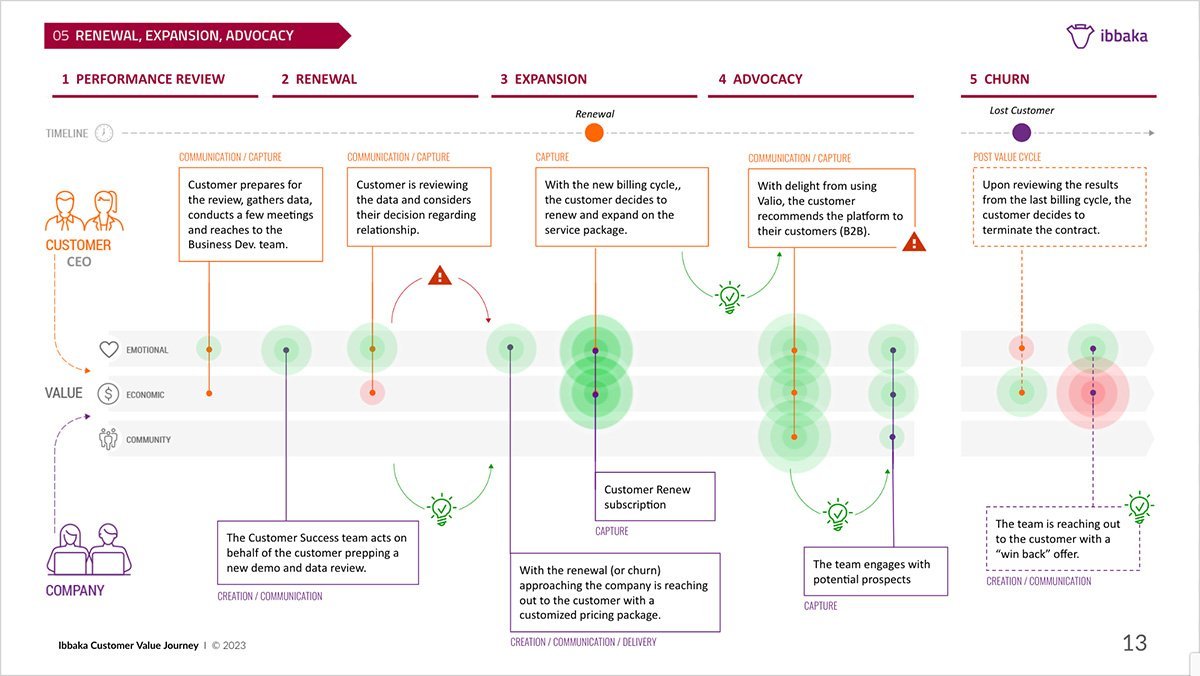My name is Human Center
By Gregory Ronczewski, Director of Product Design at Ibbaka. See his skill profile.
Five weeks ago, I wrote a post inviting you to explore with me the nuances of making a Customer Journey, to be precise, a Customer Value Journey. The emphasis is on Value. Then, two weeks ago, in a follow-up post, I shared a few thoughts on possible visualization of how the value drivers—emotional, economic and community—may bring each phase of the journey into a functional display. It is apparent by now that the work surrounding those journeys (we have one for each persona) has a "resonating" effect on the whole team - hence my last post, Sympathetic Resonance. So today, I am inviting you one more time to walk with me along the value path, this time considering if we could find evidence supporting Human Centered Design. To make it more interesting, the Customer Value Journey I am working on covers the experience of Ibbaka's B2B clients, which adds to the complexity of how we look at the customer's experience. However, ultimately, there are real people who connect, interact, and hopefully form a relationship with Ibbaka through our SaaS product or services - perhaps different from C2C but still very personal when it comes to the experience.
There are many definitions of Human Centered Design (HCD). For example, Invision, the prototyping gurus define HCD as
"A framework that integrates a set of practices to understand users—their needs, constraints, contexts, behaviours, and wants—so that you can build deep empathy with them, generate multiple ideas to help solve their problems - a design approach that puts the users first, resulting in useful and usable products and services."
Sounds good, right? Although, I wonder who would design a product or a service without addressing the needs of a person or a group of people. Well, many of those services and products exist around us - we call them useless—useless products, hopeless services, offering ineffective solutions. So, where do we start to avoid major pitfalls?
I found a video from NN/g where Don Norman talks about the Principles of Human-Centered Design. In this short 3 minutes clip, he beautifully summarizes the essence, the overarching principle that resonates with me on many levels. Initially, I thought I would just link the video, but then I realized many of you will not click. So instead, I have the video right here - click play. It's worth it.
Don Norman points to the apparent fact that often escapes us - the fact that regardless of the design, there are real people who will experience our design. And not only the direct users but the whole community behind it. After graduation, my first real job was in an architecture studio. I still recall sleepless nights, fearing that my solutions would lead to an accident. There is a difference between an unfortunate brochure layout and a wrongly calculated staircase. Let's go back to Don Norman and Customer Value Journey. Designers create personas, avatars, and imaginary actions to visualize a product or service. Although it works to a certain degree, observing people, connecting with them, and learning first-hand is the best way to propose delight areas with the most impact. The best way is to start with ourselves. Use the product or talk to the users. We have been fortunate with clients who share their opinions, informing our internal processes.
The second point he makes is that, in many cases, the design focuses on a problem which really is not a problem but a symptom. Addressing only the symptom will never permanently cure the problem. Asking why multiple times gets the design closer to finding the root cause. Addressing the root cause will eternally remove all the symptoms, and issues will vanish without a trace. I have a direct experience in a health project where finding the root cause instead of addressing symptoms changed the outcome into something unimaginable.
And I genuinely love his next point - the local versus global. Design often focuses on details, minor adjustments, and changes ignoring the high-level view. It is natural to tackle tangible components, elements that we can control with instant results. But it doesn't mean we can dismiss the global perspective for a product or a service. What is the end goal? How can we predict the flow from one phase to the next, keeping in front of us the North Star, the outcome that the user is aiming at? We are all different, and we perceive the world uniquely. Customer Journeys, especially Value Journeys, tend to generalize some actions. We can't have an unforgettable journey for every user, but we can optimize them along the milestones and the value goals - the final result that matters. Everything is a system, a living organism (even the products if we examine them with users, not separate) and should be looked at holistically. It is the only way to see the trees from the forest - be able to name all the growing species without losing sight of the horizon.
Although I describe the internal process we apply to inform and improve Ibbaka Valio, our end-to-end Customer Value Management solution, this blog is closely connected to Ibbaka Talio, the Skill and Talent Management platform. Both are different but share a few fundamental beliefs, and we accept that improving one side of the business affects the other.



